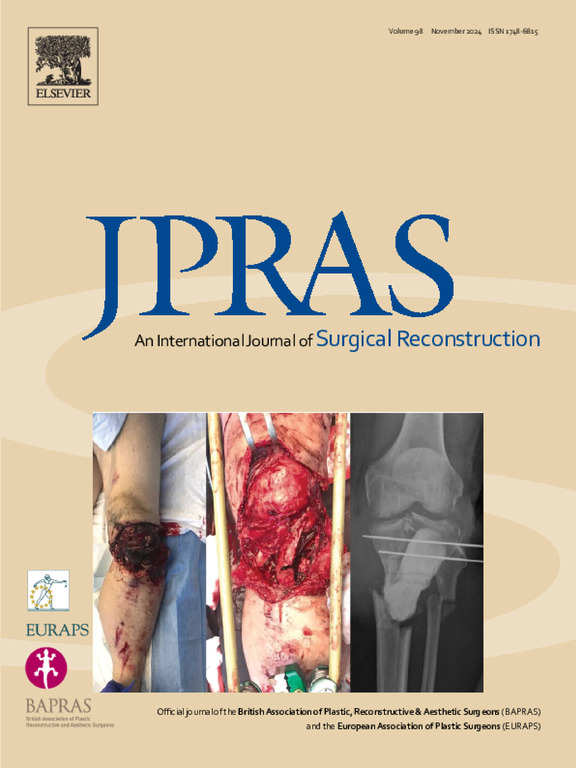Incidence of and risk factors for post-operative venous thromboembolism after free flap breast reconstruction in a London teaching hospital: A retrospective cohort study
IF 2
3区 医学
Q2 SURGERY
Journal of Plastic Reconstructive and Aesthetic Surgery
Pub Date : 2024-10-01
DOI:10.1016/j.bjps.2024.09.084
引用次数: 0
Abstract
Objective
The objective of this study was to determine the incidence of venous thromboembolism (VTE) following autologous breast reconstruction, assess risk factors that may predict incidence and assess the accuracy of the Caprini risk assessment model.
Background
VTE is a rare, but potentially lethal complication of autologous breast reconstruction. An accurate preoperative risk-stratification strategy is essential to improve patient outcomes by determining the patients who would benefit from extended thromboprophylaxis after surgery.
Methods
Patients who underwent autologous free flap breast reconstruction at a London teaching hospital from 2019–2021 were included. Risk factors for VTE were analysed. VTE incidence was assessed, and the risk factors were identified using multivariate analysis.
Results
Overall, 368 patients were included in the study. Among them, 10 (2.72%) had a confirmed diagnosis of post-operative VTE, at an average of 23 days after surgery (range 3–64 days). All VTEs occurred in deep, inferior epigastric artery perforator flap patients with a history of breast cancer. Multivariate regression analysis revealed a statistically significant correlation between the incidence of VTE and Caprini score (p = 0.030) and length of hospital stay (p = 0.007). Tamoxifen use was individually significant for VTE (p = 0.043) but non-significant (p = 0.106) when confounded for length of hospital stay (LOS) and Caprini score.
Conclusions
Current VTE risk assessment tools do not accurately identify patients who are at risk of developing VTE following free flap breast reconstruction. The Caprini risk assessment model and LOS may be useful in predicting post-operative VTE in this cohort. These patients may benefit from extended chemoprophylaxis. Larger prospective studies are required to optimise risk prediction models in this cohort.
伦敦一家教学医院的游离皮瓣乳房再造术后静脉血栓栓塞的发生率和风险因素:回顾性队列研究
本研究旨在确定自体乳房重建术后静脉血栓栓塞症(VTE)的发病率,评估可能预测发病率的风险因素,并评估 Caprini 风险评估模型的准确性。准确的术前风险分级策略对改善患者预后至关重要,因为它能确定哪些患者在术后将受益于延长的血栓预防措施。方法纳入了2019-2021年在伦敦一家教学医院接受自体游离瓣乳房重建术的患者。分析了VTE的风险因素。评估了 VTE 发生率,并通过多变量分析确定了风险因素。其中,10 例(2.72%)确诊为术后 VTE,平均发生时间为术后 23 天(范围为 3-64 天)。所有 VTE 均发生在有乳腺癌病史的深部上腹下动脉穿孔皮瓣患者身上。多变量回归分析显示,VTE发生率与Caprini评分(p = 0.030)和住院时间(p = 0.007)之间存在统计学意义上的显著相关性。结论目前的 VTE 风险评估工具不能准确识别游离皮瓣乳房再造术后有 VTE 风险的患者。Caprini风险评估模型和LOS可能有助于预测此类患者的术后VTE。这些患者可能会从延长的化学预防中获益。需要进行更大规模的前瞻性研究,以优化该群体的风险预测模型。
本文章由计算机程序翻译,如有差异,请以英文原文为准。
求助全文
约1分钟内获得全文
求助全文
来源期刊
CiteScore
3.10
自引率
11.10%
发文量
578
审稿时长
3.5 months
期刊介绍:
JPRAS An International Journal of Surgical Reconstruction is one of the world''s leading international journals, covering all the reconstructive and aesthetic aspects of plastic surgery.
The journal presents the latest surgical procedures with audit and outcome studies of new and established techniques in plastic surgery including: cleft lip and palate and other heads and neck surgery, hand surgery, lower limb trauma, burns, skin cancer, breast surgery and aesthetic surgery.

 求助内容:
求助内容: 应助结果提醒方式:
应助结果提醒方式:


